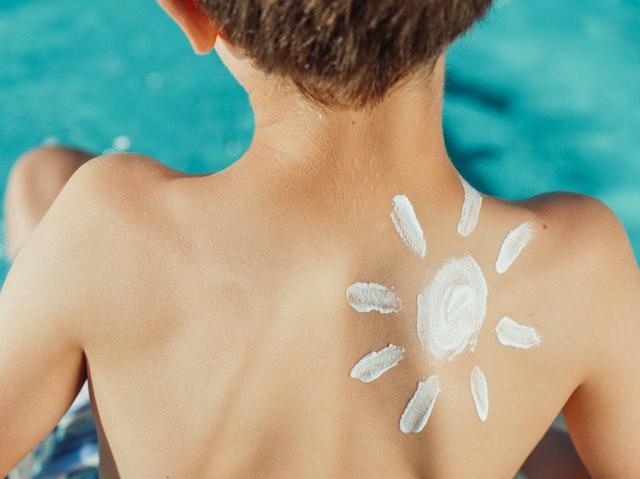Teach Your Kiddos to Be Sun Safe
June 14, 2021
by Catherine Davis, MD

Summer’s here and our kiddos are playing outside, running through the sprinkler, splashing in the lake. And just as you are trying to apply the last swipe of sunscreen on their back, they slip out of your grasp to go play. Yep, smearing sunscreen on a little one requires some skill, quick reflexes and humor. But you got this!
Protecting our children from the sun helps prevent sunburn and reduce their risk for skin cancer. While the sun hasn’t gotten any stronger, the ozone layer which protects us from the sun’s harmful UV rays has gotten thinner. Every sunburn, no matter how mild, is a sign of skin damage that can lead to skin cancer and premature aging.
The American Academy of Dermatology offers these sun safety tips for families.
Seek shade. The sun’s rays are strongest between 10 a.m. and 4 p.m. Shade is especially important during this time. Show your children that when their shadow is shorter than they are, the sun is strongest. That’s when they should find shade. And keep babies in the shade as much as possible.
Select the right sunscreen. Choose a broad spectrum sunscreen which means the sunscreen protects the skin from ultraviolet A (UVA) and ultraviolet B (UVB) rays, both of which cause skin cancer. Choose a sunscreen that is SPF 30 or higher. You can choose between “water resistant” for 40 minutes or “very water resistant” for 80 minutes. Remember, no sunscreen is waterproof or sweat proof.
Apply sunscreen generously. Use enough sunscreen to cover all skin that clothing doesn’t cover. Most adults need about 1 ounce, or enough to fill a shot glass, to fully cover the body. Apply sunscreen to dry skin 15 minutes before going outdoors. Don’t forget the tops of the feet and ears. To protect the lips, use a lip balm with an SPF of 15+. Reapply sunscreen every 2 hours, after swimming or sweating, and even if it’s cloudy. UV rays can still penetrate through cloud cover.
Use lotions, not sprays. While sprays may be more convenient, dermatologists recommend lotions. Lotions offer more protection as you can tell how much you are applying. People tend to use less than needed when sunscreen is sprayed on. Spray sunscreen can also be inhaled into the lungs. Sunscreen sticks work well near the eyes and on faces.
Dress to protect. Wear a lightweight and long-sleeved shirt, pants, a wide-brimmed hat and sunglasses when possible. Select clothes made with a tight weave as they protect better than clothes with a looser weave. You can hold the fabric up to see how much light shines through. The less light, the better.
Try UPF clothing. Clothing with an Ultraviolet Protection Factor (UPF) of 30+ offers very good protection while UPF 50+ offers excellent protection. A UPF of 50 blocks 98% of UV rays. A white T-shirt has a UPF of about 7! UPF swim shirts are a great choice for boys and girls alike. It’s often easier to throw on a sunproof swim shirt than keeping them covered in sunscreen.
Have fun in the sun, but play it safe. Your kids will thank you someday!